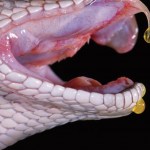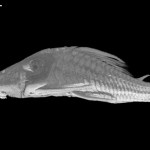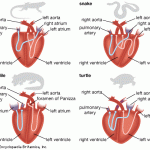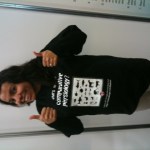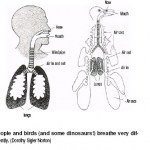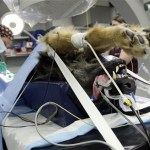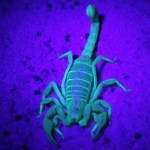
Image: PopSci
Researchers have been finding treatments for various conditions in what might be considered by many to be the least expected place: venoms. These toxic substances can cause reactions ranging from mildly annoying to deadly depending on the animal. But in small doses or in purified forms, these toxins are just the right medicine for some people. Here are some drugs derived from various animals:
-Captopril, used to treat hypertension, isolated from pit vipers
-Exenatide (Byetta), used to treat diabetes, isolated from gila monsters
-Xen2174, used to treat severe pain, isolated from…
Just in case you were ever wondering what a beetle looks like on the inside, here is a computed microtomography video of a Dryops water beetle.
Other researchers are using this tool to examine the anatomy of various extant and extinct organisms. In fact, there is an online digital library of specimens that you can explore at The University of Texas at Austin (sponsored by the National Science Foundation).
Here are a few of my favorites:
Panaque cf. nigrolineatus, Royal Pleco Catfish
Dr. Nathan Lujan - Texas A&M University
Juvenile Gila Monster (Heloderma suspectum) (false-color 3D…
I have had a lot of fun at this year's Experimental Biology conference. I always enjoy attending the symposia to listen to current research news as well as interact with fellow comparative physiologists at all levels of training. Here are the highlights from the sessions on Tuesday and Wednesday:
Tuesday:
J. Hicks, August Krogh Lecture: "Tales from the heart: A comparative and evolutionary perspective of the vertebrate circulatory system"
Dr. Hicks gave a wonderful talk on the evolution of the heart and the physiological purpose of shunting that occurs in the crocodilian heart, which is four…
Meet Dr. Heidy Contreras, a Postdoctoral Fellow at The University of Arizona and the latest winner of a Starbucks gift card for showing off her pride in comparative physiology at the 2012 Experimental Biology meeting!
Here are my favorite posters from today's session:
-Scott G, Schnurr ME, Yin Y, Johnston IA. "Embryonic temperature produces persistent effects on the capacity for thermal acclimation in adult zebrafish"
Scott et al., found that exposing embryonic zebrafish to varying temperatures impacted the animal's ability to acclimate (swimming performance) to different temperatures as an adult. The effect was at least partially attributed to differences in the development of muscle fiber types with varying temperatures.
-Howard SA, Rothstein K, Laske TG, Garshelis DL, Iaizzo PA. "Estimating water…
Meet Patricia Villalta, from the University of South Alabama College of Medicine, our final winner of the "What's New in Comparative Physiology" t-shirt contest! The letter explaining her reasons for being excited about the Experimental Biology conference were inspirational. May you always show such enthusiasm for research and comparative physiology Patricia!
Meet Dr. Rudy Ortiz from the University of California, Merced. He is a winner of our show your pride in comparative physiology at EB contest! In case you can't tell from his tie, he is passionate about his research with seals. Congratulations Rudy! Enjoy your Starbucks gift card.
Highlights from the afternoon seminars:
D. Schlenk, "Estrogenic activities in marine wildlife: potential causes and population impacts"
Dr. Schlenk has been studying the estrogenic effects of Bifenthrin, a pyrethroid insectide in fish populations. He observed that male fish exposed to this chemical actually show an increase in vitellogenin, which is important in the development of eggs in female fish. More importantly, other pesticides, including Befenthrin, and alpha polyethoxylate (APEO) chemicals have been detected in the San Francisco Bay and may be related to declines in the fish…
G
Highlights from the morning sessions
Hypoxia inducible factors in health and disease
G. Haddad, "Genomic information controlling the adaptation to long term hypoxia: insights from flies and humans"
Dr. Haddad's laboratory has discovered that hypoxia tolerance is inherited in flies. When naive flies are exposed to anoxia (no oxygen) for 1-3 hours, they become immobile but recover fully with subsequent exposure to room air. His team exposed generations of flies to decreasng oxygen conditions and after more than 32 generations, the flies were able to function well in only 3.5% oxygen and had…
I arrived in beautiful San Diego this afternoon and just checked in to the conference. I am really looking forward to the Walter Cannon Lecture this evening as well as the APS 125th Anniversary Opening Ceremony and beach party! I look forward to catching up on what's new in comparative physiology over the next few days and will be sure to fill you in on the highlights!
In looking through the online program for this years' EB, I came across additional comparative physiology seminars that I am very much looking forward to attending (to see the prior list of must-see seminars, click here):
Monday April 23rd:
8:00am-10:00am: "Hypoxia Inducible Factors in Health and Disease," chaired by B. Rees, CG Wilson, and M Watanabe.
10:30-12:30: "Sodium and water homeostasis: Genetic and comparative models," chaired by T Pannabecker and K Hyndman.
12:45-3:15pm: Don't forget to attend the Scholander poster session to meet the future scientists in comparative physiology…
Congratulations to Patricia Villalta, a graduate student at the University of South Alabama College of Medicine, our final winner of the "What's New in Comparative Physiology?" t-shirt contest! Here are her reasons for being excited about going to this year's Experimental Biology meeting:
"Dear Dr. Dolittle,
Every year, I get excited about the Experimental Biology meeting because unexpected opportunities are bound to happen. For example, this past year, I attended for the first time the Science Policy Committee's Symposium "How to Become An Advocate: A Workshop for Scientists", where I…
Don't forget to show your pride in comparative physiology at this year's EB. If you get caught wearing something that says "comparative physiology", "Dr. Dolittle", or "Life Lines," by one of the APS staffers or members of The American Physiological Society's Communications Committee, you just may win free coffee!
I don't know about you, but I am getting very excited about the upcoming Experimental Biology conference in San Diego! Our posters have been printed and I am just taking a break from pouring over the program to decide which sessions and posters I will be visiting. These…
As fun as it was to think about developing wings to fly like a bird, physics always wins. In case you haven't yet figured it out, the prior video was of course a fake, albeit a really entertaining fake.
That being said, here is the first ornithopter able to sustain flight. The aircraft was created by a student in the Engineering PhD program at The University of Toronto, Todd Reichert in 2010. It is human-powered and the wings are designed to mechanically flap like those of a bird:
Source
University of Toronto News
Most birds fly. To aid flight, avian bones are hollow, reducing their mass. In addition, bird wings and feathers are optimally designed for flight.
So why can't large birds or mammals fly? One of the problems is that they are too heavy to lift off the ground, necessitating unrealistically large wings to make it happen. However, it seems as if someone might have figured out how to design human wings for flight:
An analysis of whether or not this popular video is potentially real or fake is presented in a post from Rhett Allain, an Associate Professor of Physics at Southeastern Louisiana…
Image source: Richard Drew /AP, MSNBC
I was just reading an article from The New York Times about advances in veterinary care and the ability to diagnose as well as treat many conditions that were once considered causes for euthanasia. These included leukemia (treated with bone marrow transplants), urinary tract disorders (treated with inserting stents), arthritis (new treatment available involving stem cell transplants), and cancer (surgical removal of tumors and chemotherapy (like the dog above)) among other new technologies and techniques. Some facilities are even offering at-home…
Image Source: Kate Wong, Scientific American
Until now, I had heard of giving a dog a bone, but never a giraffe. They reportedly chew on bones as a source of minerals. This is also true for another herbivore, the desert tortoise. Who knew?
Source:
Esque, T.C., and E.L. Peters. 1994. Ingestion of bones, stones, and soil by desert tortoises. : Biology of North American Tortoises. Fish and Wildlife Research, Technical Bulletin 13. 105-1 p.
Scientific American
"The Peeps Show"
For the last several years the Washington Post has sponsored a Peeps Diorama Contest. It's an opportunity for people to express their creativity using those yellow (or pink) marshmallow candy bunnies and birds that fill grocery store shelves in the weeks leading up to the spring (and other) holidays.
One reader tried their hand at merging creativity, peeps, and comparative physiology: Their poster says, "Dr. Dolittle: We love Comparative Ph[peep]siolog[peep] because we like working with people! Anonypeeps." (One of the take-away lessons from Anonypeeps for those…
Image Source: msnbc
A new species of tiny scorpions, Wernerius inyoensis, has been discovered in Death Valley National Park by PhD student Matthew Graham from the University of Nevada Las Vegas. At 16mm long, the tiny creature is about the length of a thumbnail. He was able to spot the tiny scorpion at night by using a UV light resulting in the bright green glow in the image above.
Sources:
MSNBC
Webber MM, Graham MR, Jaeger JR. Wernerius inyoensis, an elusive new scorpion from the Inyo Mountains of California (Scorpiones, Vaejovidae) ZooKeys 177: 1-13, 2012.
